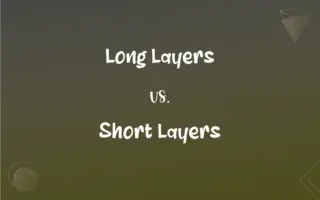Constructivism vs. Constructionism: What's the Difference?
Edited by Aimie Carlson || By Janet White || Published on February 17, 2024
Constructivism focuses on learning as an internal, individual process, while Constructionism emphasizes learning through creating external, tangible products.

Key Differences
Constructivism is a learning theory that posits knowledge is constructed internally by the learner, whereas Constructionism believes learning occurs as individuals construct physical or digital artifacts in the real world.
In Constructivism, the learner actively constructs new knowledge; in Constructionism, the learner is not just an active constructor of knowledge but also creates tangible objects as part of the learning process.
Constructivism emphasizes understanding and internalizing concepts through active, personalized learning, whereas Constructionism focuses on learning through hands-on building and making.
Constructivism often utilizes technology as a tool for exploring concepts, while Constructionism integrates technology as a means to create and build projects, emphasizing the role of tangible outputs in learning.
Constructivism highlights the importance of social context in learning, but Constructionism places greater emphasis on collaboration and sharing in the physical creation of artifacts.
ADVERTISEMENT
Comparison Chart
Learning Focus
Internal construction of knowledge.
Construction of external artifacts.
Learner's Role
Active knowledge constructor.
Builder and creator of tangible objects.
Educational Approach
Emphasizes personalized learning.
Focuses on hands-on building and making.
Technology Use
Tool for exploring concepts.
Means to create and build projects.
Social Context
Important for learning.
Emphasizes collaboration in creation.
ADVERTISEMENT
Constructivism and Constructionism Definitions
Constructivism
Constructivism builds on the learner's existing knowledge.
Constructivism leverages what students already know to explore new concepts.
Constructionism
Constructionism is learning through the process of making tangible objects.
In constructionism, building models aids in grasping scientific concepts.
Constructivism
Constructivism is the theory that knowledge is constructed by the learner.
In constructivism, students build their understanding through experiences.
Constructionism
Constructionism integrates technology in project building.
Constructionism encourages using digital tools for creative expression.
Constructivism
Constructivism emphasizes active, personalized learning.
Constructivism transforms students from passive receivers to active learners.
Constructionism
Constructionism involves creating physical or digital artifacts.
Students use robotics in constructionism to materialize their ideas.
Constructivism
Constructivism considers the social context important in learning.
Group discussions in constructivism enhance understanding through shared perspectives.
Constructionism
Constructionism emphasizes hands-on, project-based learning.
Constructionism engages students through interactive projects.
Constructivism
Constructivism is a learner-centered educational approach.
Constructivism focuses on adapting to individual learning styles.
Constructionism
Constructionism values collaboration in the creation process.
Group projects in constructionism foster teamwork and practical skills.
Constructivism
A movement in modern art originating in Moscow in 1920 and characterized by the use of industrial materials such as glass, sheet metal, and plastic to create nonrepresentational, often geometric objects.
Constructionism
(legal) A strict interpretation of the actual words and phrases used in law, rather than any underlying intent.
Constructivism
(arts) A Russian movement in modern art characterized by the creation of nonrepresentational geometric objects using industrial materials.
Constructionism
(social science) The idea that people learn about, or perceive the world by constructing mental models.
Constructivism
(mathematics) A philosophy that asserts the need to construct a mathematical object to prove it exists.
Constructivism
A psychological epistemology which argues that humans generate knowledge and meaning from their experiences.
Constructivism
An abstractionist artistic movement in Russia after World War I; industrial materials were used to construct nonrepresentational objects
FAQs
Who introduced Constructivism?
Jean Piaget, a Swiss psychologist, is considered a key figure in developing the theory of Constructivism.
How does Constructivism impact education?
In education, Constructivism shifts the focus from teacher-led instruction to student-centered learning, emphasizing active, discovery-based learning.
What is Constructivism?
Constructivism is a learning theory positing that people construct their own understanding and knowledge of the world through experiences and reflecting on those experiences.
Can Constructivism be applied in all educational levels?
Yes, it can be adapted to suit various educational levels and learning styles.
What role do teachers play in Constructivist learning?
Teachers guide and facilitate learning, encouraging students to explore, ask questions, and develop their own understanding.
How does Constructionism differ from Constructivism?
While Constructivism focuses on internal knowledge construction, Constructionism also emphasizes creating physical or digital artifacts as a part of the learning process.
How does Constructivism view the learner?
Constructivism views learners as active participants in their own learning process, rather than passive recipients of information.
Is technology important in Constructivist learning?
Technology can enhance Constructivist learning by providing interactive, engaging, and personalized educational experiences.
What are key principles of Constructivism?
Key principles include knowledge construction, active learning, and the importance of social and cultural contexts in learning.
What is Constructionism?
Constructionism is a theory related to Constructivism, emphasizing the role of building or 'constructing' tangible objects in learning.
How does Constructivism differ from traditional learning models?
Unlike traditional models that focus on rote memorization, Constructivism emphasizes understanding and application of knowledge.
Who developed Constructionism?
Seymour Papert, a mathematician and educator, developed the theory of Constructionism.
What are some criticisms of Constructivism?
Critics argue that it may lack structure and underestimate the importance of direct instruction in some areas.
How is Constructionism applied in education?
It's applied through project-based learning, where students create models, digital programs, or other artifacts to demonstrate their learning.
Does Constructionism support collaborative learning?
Yes, it often involves collaborative projects, encouraging teamwork and communication skills.
What is the significance of tangible artifacts in Constructionism?
Tangible artifacts are crucial as they provide a physical or digital representation of the learner's understanding and facilitate deeper engagement.
Can Constructionism be used in online education?
Yes, digital tools and platforms enable the creation and sharing of digital artifacts in online learning environments.
What are some challenges of implementing Constructionism?
Challenges include resource availability, the need for sufficient guidance, and balancing creativity with curriculum goals.
What are the benefits of Constructionism in learning?
Benefits include enhanced creativity, better understanding of concepts through application, and improved problem-solving skills.
How do teachers facilitate Constructionist learning?
Teachers provide resources, guidance, and feedback, helping students in the creative process and understanding the underlying concepts.
About Author
Written by
Janet WhiteJanet White has been an esteemed writer and blogger for Difference Wiki. Holding a Master's degree in Science and Medical Journalism from the prestigious Boston University, she has consistently demonstrated her expertise and passion for her field. When she's not immersed in her work, Janet relishes her time exercising, delving into a good book, and cherishing moments with friends and family.
Edited by
Aimie CarlsonAimie Carlson, holding a master's degree in English literature, is a fervent English language enthusiast. She lends her writing talents to Difference Wiki, a prominent website that specializes in comparisons, offering readers insightful analyses that both captivate and inform.






































































